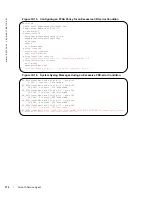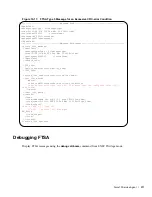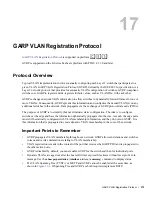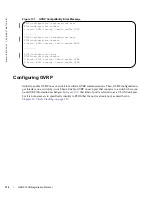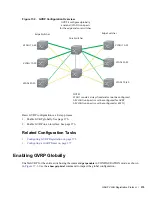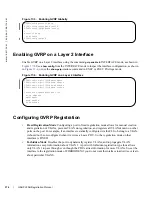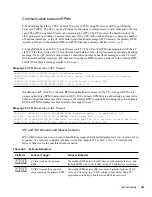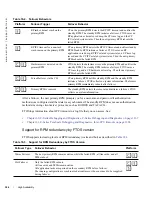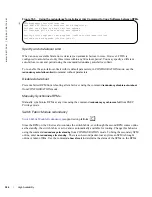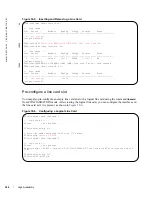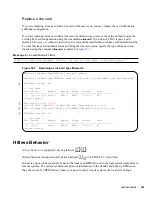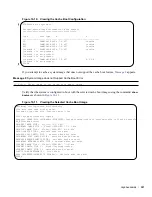
High Availability |
383
Communication between RPMs
E-Series RPMs have three CPUs: Control Processor (CP), Routing Processor 1 (RP1), and Routing
Processor 2 (RP2). The CPUs use Fast Ethernet connections to communicate to each other and to the line
card CPUs (LP) using Inter-Processor Communication (IPC). The CP monitors the health status of the
other processors by sending a heartbeat message. If any CPU fails to acknowledge a consecutive number
of heartbeat messages, or the CP itself fails to send heartbeat messages (IPC timeout), the primary RPM
requests a failover to the standby RPM, and FTOS displays a message similar to
Message 4
.
C-Series RPMs have one CPU: Control Processor (CP). The CP on the RPM communicates with the LP
via IPC. Like the E-Series, the CP monitors the health status of the other processors by sending a heartbeat
message. If any CPU fails to acknowledge a consecutive number of heartbeat messages, or the CP itself
fails to send heartbeat messages (IPC timeout), the primary RPM requests a failover to the standby RPM,
and FTOS displays a message similar to
Message 4
.
In addition to IPC, the CP on the each RPM sends heartbeat messages to the CP on its peer RPM via a
process called Inter-RPM Communication (IRC). If the primary RPM fails to acknowledge a consecutive
number of heartbeat messages (IRC timeout), the standby RPM responds by assuming the role of primary
RPM, and FTOS displays message similar to message
Message 5
.
IPC and IRC timeouts and failover behavior
IPC or IRC timeouts can occur because heartbeat messages and acknowledgements are lost or arrive out of
sequence, or a software or hardware failure occurs that impacts IPC or IRC.
Table 18-2
describes the
failover behavior for the possible failure scenarios.
Message 4
RPM Failover due to IPC Timeout
%RPM1-P:CP %IPC-2-STATUS: target rp2 not responding
%RPM0-S:CP %RAM-6-FAILOVER_REQ: RPM failover request from active peer: Auto failover on
failure
%RPM0-S:CP %RAM-6-ELECTION_ROLE: RPM0 is transitioning to Primary RPM.
%RPM0-P:CP %TSM-6-SFM_SWITCHFAB_STATE: Switch Fabric: UP
Message 5
RPM Failover due to IRC Timeout
20:29:07: %RPM1-S:CP %IRC-4-IRC_WARNLINKDN: Keepalive packet 7 to peer RPM is lost
20:29:07: %RPM1-S:CP %IRC-4-IRC_COMMDOWN: Link to peer RPM is down
%RPM1-S:CP %RAM-4-MISSING_HB: Heartbeat lost with peer RPM. Auto failover on heart beat lost.
%RPM1-S:CP %RAM-6-ELECTION_ROLE: RPM1 is transitioning to Primary RPM.
Table 18-2. Failover Behaviors
Platform
Failover Trigger
Failover Behavior
c e
CP task crash on the primary
RPM
The standby RPM detects the IRC time out and initiates failover, and
the failed RPM reboots itself after saving a CP application core dump.
c e
CP IRC timeout for a non-task
crash reason on the primary RPM
The standby RPM detects IRC time out and initiates failover. FTOS
saves a CP trace log, the CP IPC-related system status, and a CP
application core dump. Then the failed RPM reboots itself.
Summary of Contents for Force10 E300
Page 1: ...FTOS Configuration Guide FTOS 8 4 2 7 E Series TeraScale C Series S Series S50 S25 ...
Page 32: ...32 w w w d e l l c o m s u p p o r t d e l l c o m ...
Page 132: ...132 802 1X w w w d e l l c o m s u p p o r t d e l l c o m ...
Page 310: ...310 Configuration Replace and Rollback w w w d e l l c o m s u p p o r t d e l l c o m ...
Page 330: ...330 Dynamic Host Configuration Protocol w w w d e l l c o m s u p p o r t d e l l c o m ...
Page 402: ...402 High Availability w w w d e l l c o m s u p p o r t d e l l c o m ...
Page 462: ...462 Interfaces w w w d e l l c o m s u p p o r t d e l l c o m ...
Page 482: ...482 IPv4 Addressing w w w d e l l c o m s u p p o r t d e l l c o m ...
Page 506: ...506 IPv6 Addressing w w w d e l l c o m s u p p o r t d e l l c o m ...
Page 582: ...582 Layer 2 w w w d e l l c o m s u p p o r t d e l l c o m ...
Page 642: ...642 Multicast Source Discovery Protocol w w w d e l l c o m s u p p o r t d e l l c o m ...
Page 662: ...662 Multiple Spanning Tree Protocol w w w d e l l c o m s u p p o r t d e l l c o m ...
Page 690: ...690 Object Tracking w w w d e l l c o m s u p p o r t d e l l c o m ...
Page 754: ...754 PIM Dense Mode w w w d e l l c o m s u p p o r t d e l l c o m ...
Page 784: ...784 PIM Source Specific Mode w w w d e l l c o m s u p p o r t d e l l c o m ...
Page 800: ...800 Power over Ethernet w w w d e l l c o m s u p p o r t d e l l c o m ...
Page 876: ...876 Quality of Service w w w d e l l c o m s u p p o r t d e l l c o m ...
Page 892: ...892 Routing Information Protocol w w w d e l l c o m s u p p o r t d e l l c o m ...
Page 1006: ...1006 Simple Network Management Protocol w w w d e l l c o m s u p p o r t d e l l c o m ...
Page 1018: ...1018 SONET SDH w w w d e l l c o m s u p p o r t d e l l c o m ...
Page 1048: ...1048 Broadcast Storm Control w w w d e l l c o m s u p p o r t d e l l c o m ...
Page 1096: ...1096 Uplink Failure Detection UFD w w w d e l l c o m s u p p o r t d e l l c o m ...
Page 1098: ...1098 Upgrade Procedures w w w d e l l c o m s u p p o r t d e l l c o m ...
Page 1196: ...1196 C Series Debugging and Diagnostics w w w d e l l c o m s u p p o r t d e l l c o m ...
Page 1252: ...1252 Standards Compliance w w w d e l l c o m s u p p o r t d e l l c o m ...
Page 1262: ...1262 Index w w w d e l l c o m s u p p o r t d e l l c o m ...


